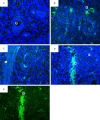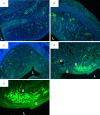Quercetin induces morphological and proliferative changes of rat's uteri under estrogen and progesterone influences
- PMID: 25337190
- PMCID: PMC4203161
Quercetin induces morphological and proliferative changes of rat's uteri under estrogen and progesterone influences
Abstract
This study investigated the effect of 10 or 100 mg/kg/day quercetin on the uterus of ovariectomized adult female rats receiving sex-steroid replacement regime mimicking changes in hormonal profiles during the reproductive cycle. Following seven days of treatment with estrogen and progesterone with or without quercetin, uteri were harvested for histological and proliferative cell nuclear antigen (PCNA) protein and mRNA expression and PCNA protein distribution analyses. Our findings indicated that co-administration of 10 mg/kg/day quercetin with estrogen and progesterone caused a significant decrease in the size of uterine lumen and epithelial heights with lower PCNA protein and mRNA expression as compared to estrogen plus progesterone-only treatment (P < 0.05). Concomitant treatment with estrogen and progesterone with 100 mg/kg/day quercetin resulted in a marked increase in the number of glands with increased PCNA protein and mRNA expression. Significantly higher PCNA distribution was observed in the stroma and glands as compared to estrogen plus progesterone-only treatment (P < 0.05). In conclusion, at 10 mg/kg/day, quercetin affects uterine morphology but not proliferation, however at 100 mg/kg/day, quercetin induced significant stromal and glandular proliferation which could predispose the uterus towards neoplastic development.
Keywords: PCNA; Quercetin; proliferation; uterus.
Figures







References
-
- Formica J, Regelson W. Review of the biology of quercetin and related bioflavonoids. Food Chem Toxicol. 1995;33:1061–1080. - PubMed
-
- Kurzeja E, Stec M, Synowiec-Wojtarowicz A, Jowsa A, Pawłowska-Góral K. Studies on the effect of quercetin and nitrates on the redox homeostasis using in vitro model. Environ Toxicol Pharmacol. 2014;38:24–30. - PubMed
-
- García-Lafuente A, Guillamón E, Villares A, Rostagno MA, Martínez JA. Flavonoids as anti-inflammatory agents: implications in cancer and cardiovascular disease. Inflamm Res. 2009;58:537–552. - PubMed
Publication types
MeSH terms
Substances
LinkOut - more resources
Full Text Sources
Miscellaneous
